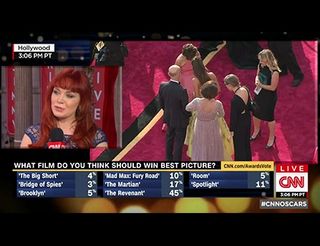‘Participation TV’ Pushes Engagement, Revenue

At a time when the TV business is looking to reduce commercials, a company working behind the scenes to allow viewers to interact with what they see on TV is looking to raise its profile and give networks new elements to sell to sponsors.
The company, iPowow, has added former National Geographic Channel ad sales head Rich Goldfarb to its board of advisors. He’s helping to push networks and advertisers to add elements to their shows that allow viewers to participate in what they see on their screen through polls, games and social media.
The idea of interactive TV has been around for years. Interacting directly with the TV via a remote control has proved problematic and synching a second screen—either a laptop or tablet—had limited appeal.
But iPowow links its data cloud to the graphics systems at a network or TV station, letting viewers punch buttons on mobile devices and see the results on the TV. Noting that 85% of viewers watch TV with a mobile device in their hand, the company calls this “Participation TV.” Information about those viewers is collected by the system, creating a valuable database.
“Media is now a two-way street, except for that final bastion of power, the linear TV screen,” said Gavin Douglas, CEO and cofounder of iPowow. “We don’t want to be an app platform, or a tech platform. This is about television because that’s where the story is, and that’s where the narrative is, and that’s where the money is.”
At first, iPowow worked with live programming such as news or sports. ESPN and Fox Sports were early users. Viewer polls powered by iPowow were part of CNN’s Oscars red carpet coverage and ratings were up 15%-20%. “They said, we’ll give you half that,” according to Douglas, “and 7%-8% isn’t bad on an event like that.”
Next the company moved to taped shows. On USA Network, interactive quizzes are part of Modern Family episodes.
Broadcasting & Cable Newsletter
The smarter way to stay on top of broadcasting and cable industry. Sign up below
“Viewers are now part of the story,” said Douglas. And of course, those interactive elements can be sponsored, creating new revenue for the programmer.
iPowow already has marketing service agreements with major TV companies, including ABC, Turner and Fox. It recently added a bunch of regional sports networks and stations.
“We’ve got everybody signed up, but we’re only in a show here and there,” said Douglas, estimating that the company has tapped about 5% of its potential.
“The vision for the company is to go from a show here, a show there, to being across multiple shows on multiple networks within the next 12-18 months,” he said. “The driver is that the networks themselves make all the money, because they pay us a yearly license fee to use the platform. We train them how to do it and their producers run it and their ad sales guys make a massive delta on the inventory sales on the other end.”
Goldfarb thinks what iPowow offers is unique. It adds to a network’s length of tune and builds engagement. “I saw a really nice opportunity to put something like this into a variety of [sponsorship] packages,” he said. “This is a totally different delivery system. Its reliability is amazing. Its ease of use is terrific. I felt very strongly ‘why doesn’t everyone have this?’ And that’s the goal.”
iPowow is now pushing game-like elements that can run before, after or during shows. Viewers play the game with their iPhones, see results on the TV screen, climb leaderboards and win prizes.
“We’ve done about 25 different shows now, across the board in taped television,” Douglas said. The system can also get social content on TV. Fox Sports uses iPowow’s system to get tweets on its air.
That’s not all. “We can push content and coupons that lead directly to a Papa John’s pizza arriving in your house an hour later,” Douglas said. “That’s the kind of drill-down that we have with the consumer.”
Jon has been business editor of Broadcasting+Cable since 2010. He focuses on revenue-generating activities, including advertising and distribution, as well as executive intrigue and merger and acquisition activity. Just about any story is fair game, if a dollar sign can make its way into the article. Before B+C, Jon covered the industry for TVWeek, Cable World, Electronic Media, Advertising Age and The New York Post. A native New Yorker, Jon is hiding in plain sight in the suburbs of Chicago.

